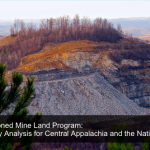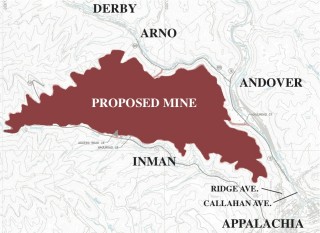Posts Tagged ‘Coal’
Promoting the Power Plan as a Plus for Appalachia
Appalachian Voices has been busy promoting the Power-Plus Plan, which would among other things support job retraining for former miners, provide funds for community infrastructure improvements and direct new funding to clean up abandoned mines while creating new jobs.
Read MoreVirginia city first to support POWER+
 The City of Norton, in southwest Virginia, has voted unanimously to support a federal budget proposal that would steer billions of dollars for economic development to coal-impacted communities, including in Virginia. It’s the first such local resolution in the nation supporting the White House’s “POWER+ Plan.” Appalachian Voices championed the resolution with Norton’s leaders and commends them for leading the way on this vital issue.
The City of Norton, in southwest Virginia, has voted unanimously to support a federal budget proposal that would steer billions of dollars for economic development to coal-impacted communities, including in Virginia. It’s the first such local resolution in the nation supporting the White House’s “POWER+ Plan.” Appalachian Voices championed the resolution with Norton’s leaders and commends them for leading the way on this vital issue.
Interior Department Issues Draft Stream Protection Rule
Contact: Cat McCue, Communications Director, 434-293-6373, cat@appvoices.org Today, the U.S. Department of the Interior issued a long-awaited draft of the Stream Protection Rule, which the agency has been working on since 2010. The purpose of the rule is to prevent or minimize the impacts of surface coal mining on surface water and groundwater. The agency’s…
Read MoreHow much progress are we making on ending mountaintop removal?
Last week, the U.S. Energy Information Administration pointed to a steep decline in coal produced by mountaintop removal mining. But
a closer examination of the data calls into question the adequacy of the legal definition of “mountaintop removal” and, more importantly, demonstrates that much more work is needed to truly end destructive mining practices in Central Appalachia.
A “golden opportunity” in disguise
 In 2013, federal funds derived from a per-ton fee on mined coal were distributed to Central Appalachia states for restoring abandoned mine lands. The result was $182 million in economic benefit and 1,317 jobs–plus cleaner streams, and a healthier future for nearby residents. A new report out shows how the federal program should be fixed to yield even better results, and sooner.
In 2013, federal funds derived from a per-ton fee on mined coal were distributed to Central Appalachia states for restoring abandoned mine lands. The result was $182 million in economic benefit and 1,317 jobs–plus cleaner streams, and a healthier future for nearby residents. A new report out shows how the federal program should be fixed to yield even better results, and sooner.
Ison Rock Ridge and land ownership in Appalachia
Earlier this summer, our friends at Southern Appalachian Mountain Stewards celebrated the defeat of a proposed mountaintop removal mine along Ison Rock Ridge in Southwest Virginia. But although the imminent threat of mining is past, the land on Ison Rock Ridge is still owned by an absentee landholding company in the business of leasing out tracts to coal operators for mountaintop removal.
Read MoreEIA: Mountaintop removal coal production down
The U.S. Energy Information Agency (EIA) published a blog post today showing that coal produced by mountaintop removal mining in Central Appalachia decreased by 62 percent between 2008 and 2014. Demand for Central Appalachian coal will continue to decline, making further progress inevitable. But we won’t end mountaintop removal by relying on the market alone.
Read More“It’s just vitamins!” Industry confuses residents on coal ash safety
Duke Energy and the N.C. Department of Environment and Natural Resources continue to confound and confuse families that have the unfortunate luck of living in close proximity to the utility’s coal ash lagoons. So citizens and county officials are stepping in to help residents air their frustrations and, hopefully, to receive some answers.
Read MoreA time of transition: APCo’s latest Virginia generation plan
It’s like Christmas in July, at least for those of us who get excited about energy news. On Wednesday Virginia’s utilities released their long-term plans to meet demand. Here we unwrap that bright shiny package for a look at what Appalachian Power is pursuing between now and 2029.
Read MoreSupreme Court delivers blow to EPA’s mercury rule
In a major decision today, the Supreme Court ruled the U.S. Environmental Protection Agency did not properly consider costs when it created a rule to limit mercury emissions from power plants. But the agency has a mandate and a clear path forward to protect public health by limiting emissions of mercury and other toxic air pollutants.
Read More




